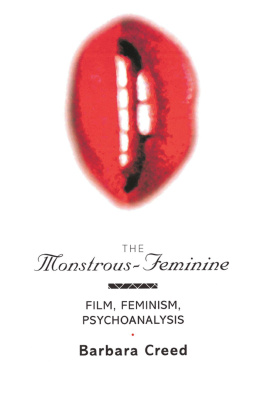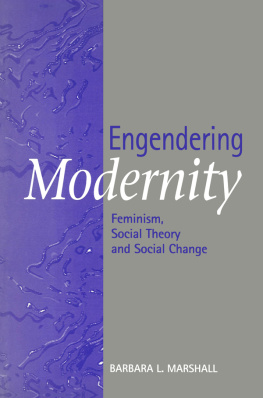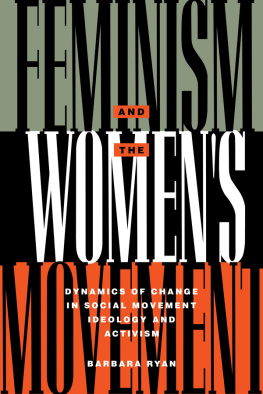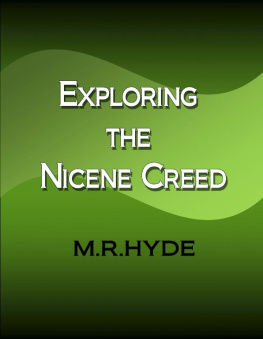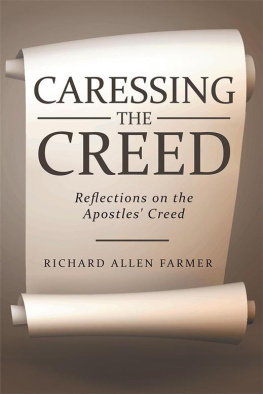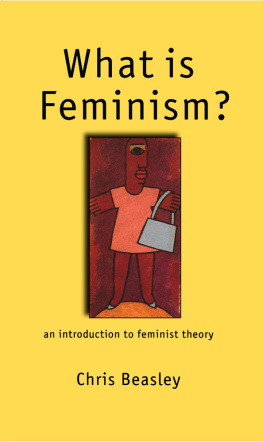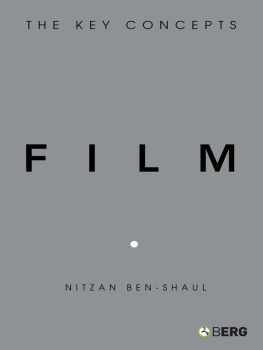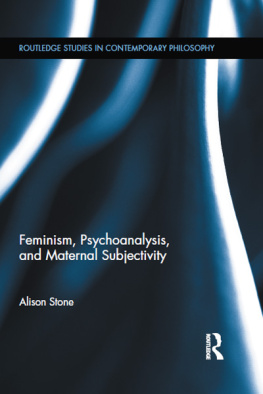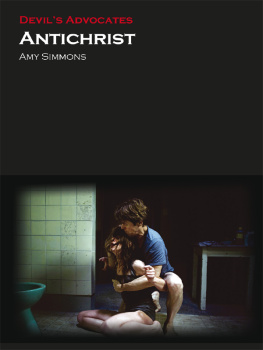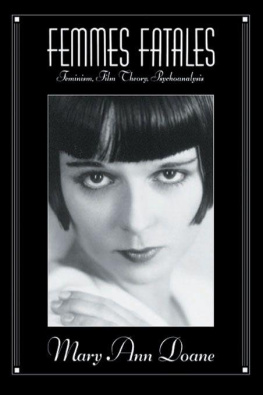Barbara Creed - The Monstrous-Feminine: Film, Feminism, Psychoanalysis
Here you can read online Barbara Creed - The Monstrous-Feminine: Film, Feminism, Psychoanalysis full text of the book (entire story) in english for free. Download pdf and epub, get meaning, cover and reviews about this ebook. year: 2015, publisher: Routledge, genre: Romance novel. Description of the work, (preface) as well as reviews are available. Best literature library LitArk.com created for fans of good reading and offers a wide selection of genres:
Romance novel
Science fiction
Adventure
Detective
Science
History
Home and family
Prose
Art
Politics
Computer
Non-fiction
Religion
Business
Children
Humor
Choose a favorite category and find really read worthwhile books. Enjoy immersion in the world of imagination, feel the emotions of the characters or learn something new for yourself, make an fascinating discovery.
- Book:The Monstrous-Feminine: Film, Feminism, Psychoanalysis
- Author:
- Publisher:Routledge
- Genre:
- Year:2015
- Rating:4 / 5
- Favourites:Add to favourites
- Your mark:
- 80
- 1
- 2
- 3
- 4
- 5
The Monstrous-Feminine: Film, Feminism, Psychoanalysis: summary, description and annotation
We offer to read an annotation, description, summary or preface (depends on what the author of the book "The Monstrous-Feminine: Film, Feminism, Psychoanalysis" wrote himself). If you haven't found the necessary information about the book — write in the comments, we will try to find it.
The Monstrous-Feminine: Film, Feminism, Psychoanalysis — read online for free the complete book (whole text) full work
Below is the text of the book, divided by pages. System saving the place of the last page read, allows you to conveniently read the book "The Monstrous-Feminine: Film, Feminism, Psychoanalysis" online for free, without having to search again every time where you left off. Put a bookmark, and you can go to the page where you finished reading at any time.
Font size:
Interval:
Bookmark:
In almost all critical writings on the horror film, woman is conceptualized only as victim. In The Monstrous-Feminine Barbara Creed challenges this patriarchal view by arguing that the prototype of all definitions of the monstrous is the female reproductive body.
Woman as castrator constitutes the most significant face of the monstrous-feminine in film, and Creed challenges the mythical patriarchal view that woman terrifies because she is castrated by arguing that woman primarily terrifies because of a fear that she might castrate. With close reference to a number of classic horror films including Alien, The Brood, The Hunger, The Exorcist, Sisters, I Spit on Your Grave and Psycho, she presents the first sustained analysis of the seven faces of the monstrous-feminine from a feminist and psychoanalytic perspective, discussing woman as monster in relation to woman as archaic mother, monstrous womb, vampire, witch, possessed body, monstrous mother and castrator.
Her argument disrupts Freudian and Lacanian theories of sexual difference as well as existing theories of spectatorship and fetishism in relation to the male and female gaze in the cinema to provide a challenging and provocative rereading of classical and contemporary film and theoretical texts of interest to all teachers and students of film, feminist theory and cultural studies.
Barbara Creed lectures in Cinema Studies at La Trobe University, Melbourne.
| Series editors: | |
| Tony Bennett | Graham Martin |
| Professor | Professor of English Literature |
| School of Humanities | Open University |
| Griffith University |
In the same series
Cover Stories:
Narrative and ideology in the British spy thriller
by Michael Denning
Lost Narratives:
Popular fictions, politics and recent history
by Roger Bromley
Popular Film and Television Comedy
by Steve Neale and Frank Krutnik
Popular Fiction:
Technology, ideology, production, reading
Edited by Tony Bennett
The Historic Romance 18901990
by Helen Hughes
Reading the Vampire
by Ken Gelder
Reading by Starlight:
Postmodern science fiction
by Damien Broderick
MONSTROUS-FEMININE
Barbara Creed

First published 1993
by Routledge
2 Park Square, Milton Park, Abingdon, Oxon, OX14 4RN
Simultaneously published in the USA and Canada
by Routledge
711 Third Avenue, New York, NY 10017
Reprinted 1994, 1997, 2001, 2006, 2007
Transferred to Digital Printing 2007
Routledge is an imprint of the Taylor & Francis Group,
an informa business
1993 Barbara Creed
Typeset in 10 on 12 point Times by
Florencetype Ltd, Kewstoke
All rights reserved. No part of this book may be reprinted or reproduced or utilised in any form or by any electronic, mechanical or other means, now known or hereafter invented, including photocopying and recording, or in any information storage or retrieval system, without permission in writing from the publishers.
British Library Cataloguing in Publication Data
Creed, Barbara
The Monstrous Feminine: Film, Feminism, Psychoanalysis. (Popular Fiction Series)
I. Title II. Series
791.43
Library of Congress Cataloguing in Publication Data
is available
ISBN10: 0-415-05258-0 (hbk)
ISBN10: 0-415-05259-9 (pbk)
ISBN13: 978-0-415-05258-0 (hbk)
ISBN13: 978-0-415-05259-7 (pbk)
Plate Section I |
[between pp. 8687 |
Plate Section II |
[between pp. 150151 |
I am extremely grateful to a large number of people who have helped make this book possible. My thanks go to Annette Blonski, Freda Freiberg, Mandy Merck, Merrilee Moss, Jane Selby, Lesley Stern and Lis Stoney for reading sections of the manuscript and offering important ideas as well as editorial assistance. In particular I wish to thank William D. Routt, my colleague at La Trobe, for his invaluable comments, theoretical insights and inspirational guidance. I also thank all those who offered me their friendship and support: in particular Sophie Bibrowska, Nanette Creed, Joyce Edwards, Joanne Finkelstein, Andrea Goldsmith, Pauline Nestor, Iris OLoughlin, Noel Purdon, John Slavin and Ishara Wishart.
Thanks also to my colleagues in the Cinema Studies Division of La Trobe University who all contributed in some way to the intellectual and social milieu in which the book was written in particular: Chris Berry, Rolando Caputo, Anna Dzenis, Dena Gleeson, Lorraine Mortimer, Beverly Purnell and Rick Thompson. I am particularly grateful to Ted Gott for his assistance with the illustrative material. Thanks also to the editorial staff at Routledge particularly Rebecca Barden, Emma Cotter and Tamsin Meddings for their excellent services and support.
The members of the feminist film group, Savage Sisters, who watched countless horror films with me deserve a special thanks: Jo Comerford, Allayne Davies, Rachelle DiDio and Krys Sykes. I also thank the many students at La Trobe University who contributed valuable insights in the horror film course I teach. Sandra Pascuzzi and Tania Rowe, from my local videostore, deserve a special vote of thanks for cheerfully keeping me up with the latest in horror.
I am particularly grateful to the Humanities Research Centre at the Australian National university for a scholarship which enabled me to have time for research and writing and in such a congenial atmosphere. I also thank those universities and institutions which invited me to present seminars on my research, particularly: Flinders University in Adelaide; the South Australian Media Resource Centre; the University of Tasmania; the George Paton Gallery; the Melbourne Writers Festival; and the Brisbane Centre for Psychoanalytic Studies. Finally, the La Trobe University Publications Committee deserves a special acknowledgement for providing a grant towards publication of the illustrative material.
I wish to thank the following individuals for their assistance with the illustrative material. Ken Berryman of the National Film and Sound Archive of Australia; Tessa Forbes of the British Film Institute, Ted Gott of the Australian National Gallery, Beverly Partridge of Films Around the World Inc; and James Sabine of the Australian Film Institute.
Illustrative material has been provided by the Kobal Collection; Design and Artists Copyright Society; Robert Le Tet of Entertainment Media; Michael Leunig of The Age, the National Film and Sound Archive of Australia; and Robert Tappert of Renaissance Pictures.
The horror film is populated by female monsters, many of which seem to have evolved from images that haunted the dreams, myths and artistic practices of our forebears many centuries ago. The female monster, or monstrous-feminine, wears many faces: the amoral primeval mother (Aliens, 1986); vampire (The Hunger, 1983); witch (Carrie, 1976); woman as monstrous womb (The Brood, 1979); woman as bleeding wound (
Font size:
Interval:
Bookmark:
Similar books «The Monstrous-Feminine: Film, Feminism, Psychoanalysis»
Look at similar books to The Monstrous-Feminine: Film, Feminism, Psychoanalysis. We have selected literature similar in name and meaning in the hope of providing readers with more options to find new, interesting, not yet read works.
Discussion, reviews of the book The Monstrous-Feminine: Film, Feminism, Psychoanalysis and just readers' own opinions. Leave your comments, write what you think about the work, its meaning or the main characters. Specify what exactly you liked and what you didn't like, and why you think so.

